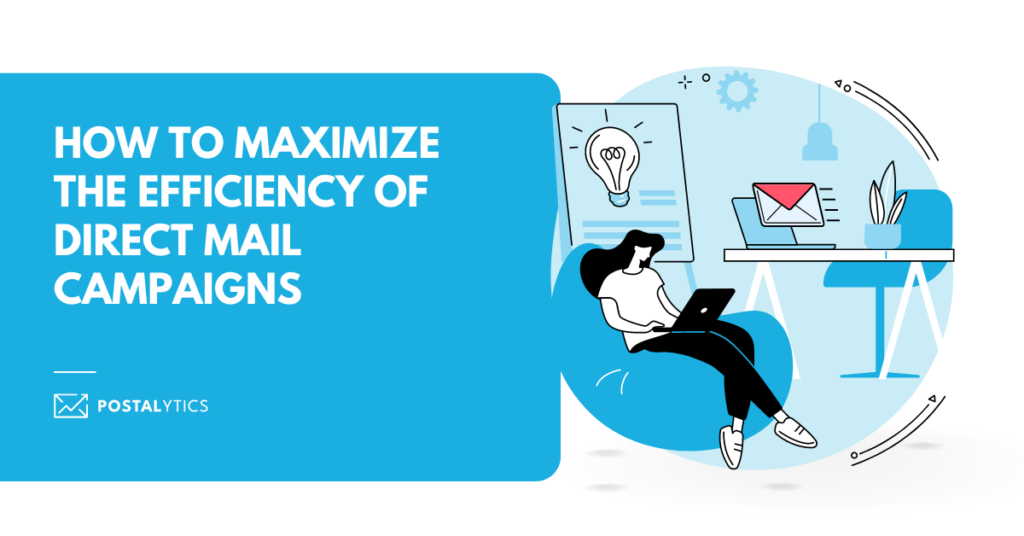
In a world overflowing with digital communication, you need to find a way to cut through the noise and reach your audience.
Direct mail campaigns can help you achieve that. With a more personalized approach and an opportunity to reach more than one customer at a time, it’s becoming imperative for brands to get a headstart on direct mail marketing.
But how do you create effective campaigns?
As a direct mail automation platform, we frequently work with companies that run direct mail campaigns. In this guide, we’ll break down all the factors that will help you maximize the efficiency of your direct mail marketing campaigns.
What We’ll Cover:
Understanding Direct Mail Marketing
Direct mail marketing involves sending physical correspondence to your audience through letters, postcards, catalogs, self-mailers, etc.
It consists of four main elements:
Target Market
The more complete your understanding of your target market is, the better you can design your direct mail marketing campaign for maximum impact. For example, the mail pieces you send to millennials would differ significantly from those you send to Gen Xers.
To define your target market, focus on areas like their goals and challenges, purchasing behavior and how they prefer to learn. Here are some questions you can ask yourself.
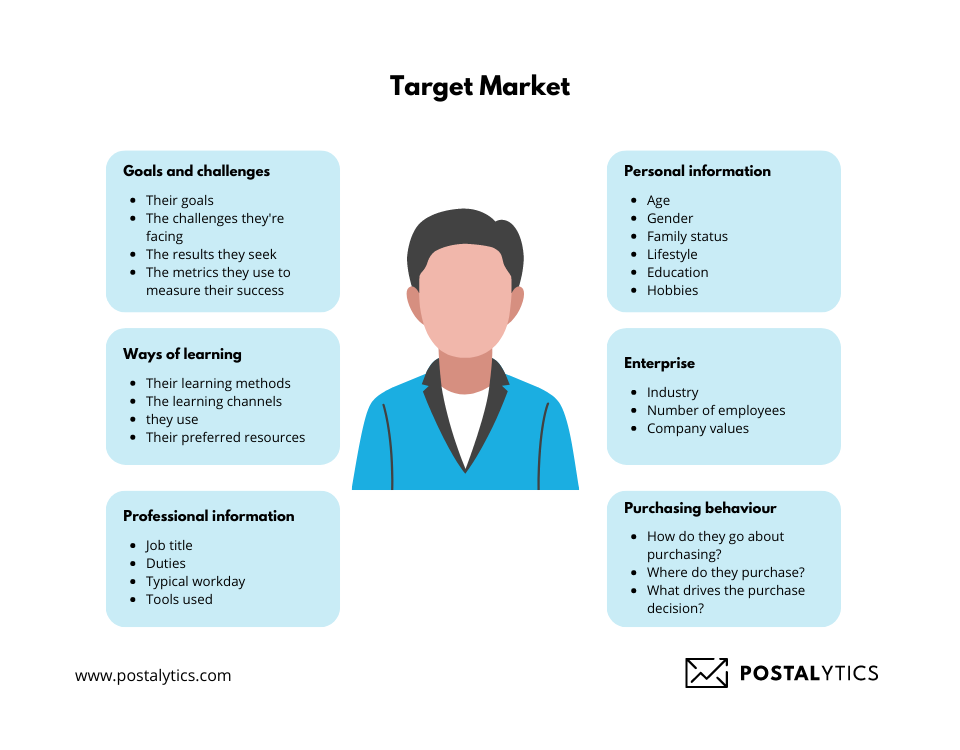
Based on the answers to these questions, you can create a target market profile like the one below.
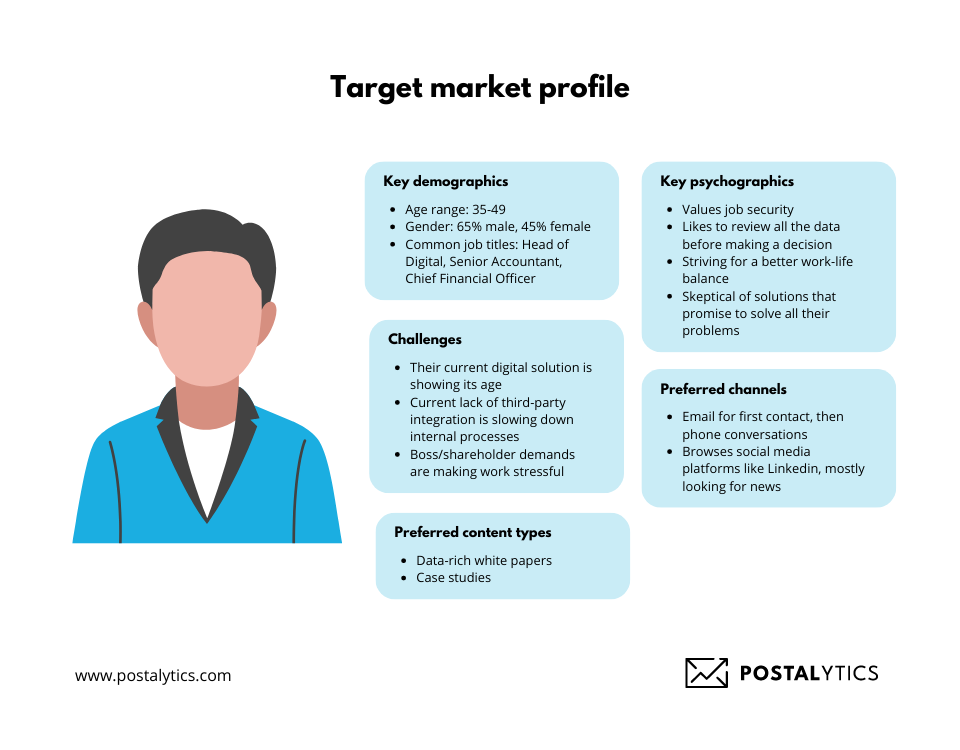
It’s important to note that your campaign target market may differ slightly from your overall target market. For example, if you’re sending a newsletter as a direct mail, your target audience would consist of people who regularly read your content through blogs, emails, and online newsletters.
Ideal Customers
Gone are the days when you sent a direct mailer to many people hoping that a few would act on the CTA. With increasing paper and postage rates, this strategy is no longer viable.
Now, you need to find potential customers who would be the right fit for your campaigns. To do that, you can ask questions like:
- What is the goal of the campaign?
- Who am I targeting with this campaign?
- Would the audience have something in common?
- Can I create a list with common behavioral or demographical characteristics?
- What kind of CTAs has this audience acted on earlier?
These questions will help you define your ideal customers for the campaign.
Mailing List
Creating mailing lists can solve many of your problems while working on a direct mail campaign.
For example, suppose you have a mailing list ready for your newsletter subscribers. In that case, you can easily use it instead of searching and assimilating all your subscribers’ addresses and relevant data.
There are two major types of mailing lists:
- House lists: These lists contain names, addresses, and other data of people who have voluntarily provided it to your business.
- Purchased lists: These lists can be purchased in the Postalytics platform, and they target a specific customer niche, industry, or demographic.
Choosing the right kind of mailing list will depend on the nature of your campaign.
Campaign Type
The campaign type you choose depends on your goals. Here are four major campaign types you can experiment with:
- Saturation mailing: This targets specific demographics or areas for your campaigns. Local businesses most commonly use this—for example, restaurants sending direct mail pieces to the people in their neighborhood.
- Lookalike modeling: In this, you create a list that is a lookalike of your existing set of customers or audience. This is majorly used when you need to extrapolate your net to gather intel on people who would likely be interested in your product.
- Retargeting: This is most commonly used by ecommerce companies that face the problem of abandoned carts and need to set up triggered retargeting drip campaigns.
- Retention mailing: While you want to keep acquiring new customers, retaining old ones is equally important. This campaign addresses direct mail related to retaining your customers.
Why is Direct Mail Marketing Effective?
Direct mail marketing is an effective strategy for reaching your target audience because it offers five key benefits:
Personalized experience
While it used to be difficult to personalize direct mail campaigns, with the advent of direct mail tools, providing a personalized experience has become easy.
For example, you can address people by their names or personalize the offer to make it more relevant to them. Many organizations also track the customer’s history to display more relevant CTAs and deals.
Here’s how Nuclear Care Partners used Postalytics to drive engagement and lead generation with a personalized experience.
With Postalytics, you can easily use variable data and logic to create different personalization elements in your campaigns.
Here’s what it looks like.
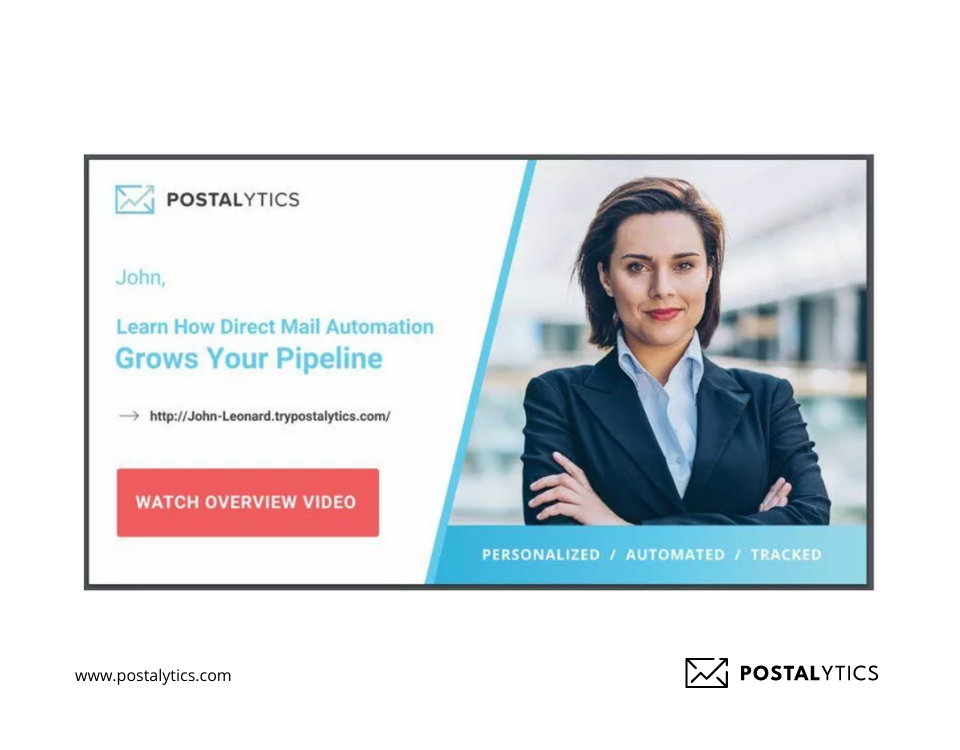
Reach a wider audience
With direct mail marketing, you can reach a wider audience in three ways:
- Reach those prospects or customers who aren’t active on social media or any other online platform.
- By sending mail to a workplace or household, you can get the attention of others too.
- By subscribing to platforms like Postalytics, you can reach people in different geographic locations.
For example, Goodman Manufacturing uses Postalytics to send monthly direct mail promotions to dealers in the U.S. and Canada.
Instead of using multiple platforms like Excel files, designing, and deploying tools, they could conduct every process on the platform and even track their direct mail pieces.
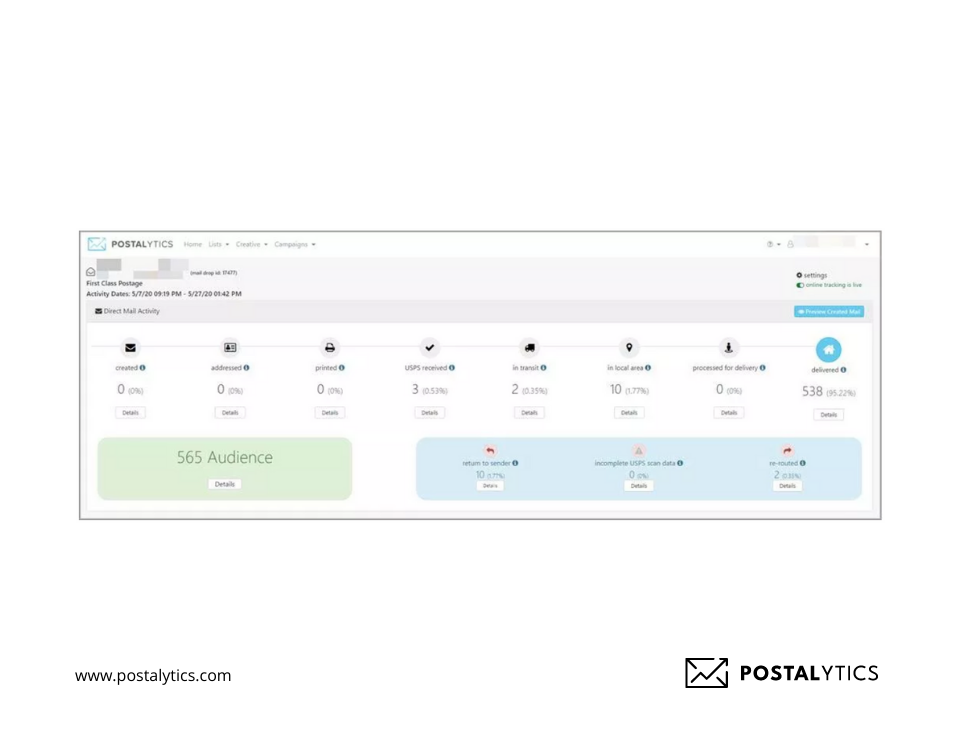
Creative form of outreach
Direct mail offers your team the chance to come up with creative campaigns. Adding personal touches to your postcards or letters can offer your audience a different experience.
There are also different ways to combine your direct mail initiatives with online initiatives.
For example, Real Living Mclemore & Co., a real estate firm in Tennessee, deployed creative triggered drip campaigns.
Here’s one co-branding example where they partnered with local businesses and featured discount coupons to get the attention of their recipients.
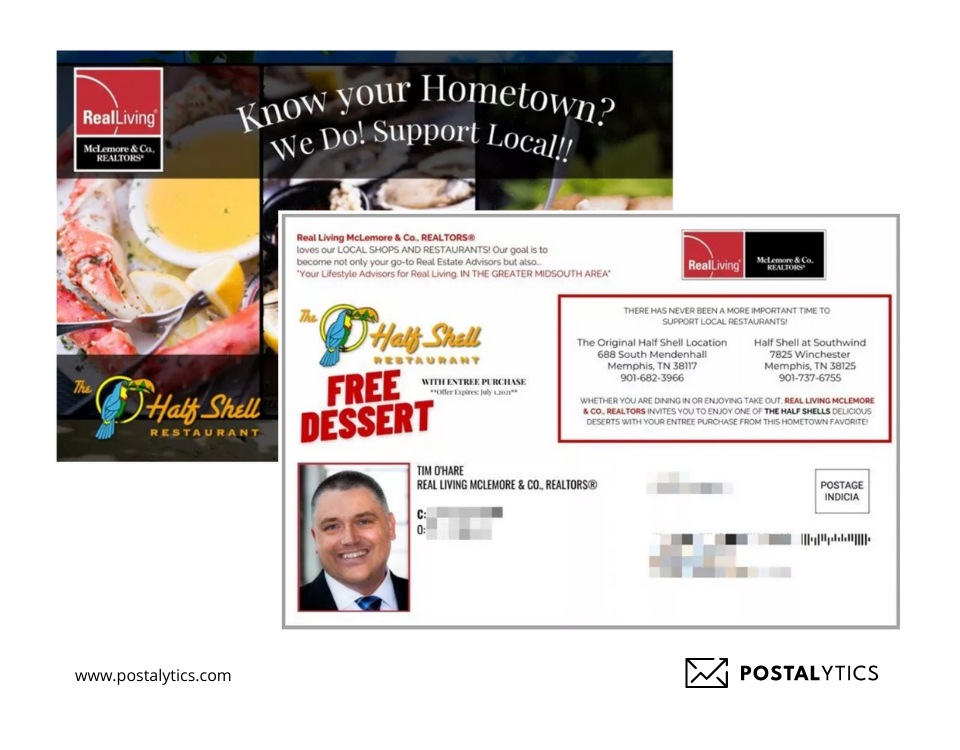
These campaigns urged prospects to visit a landing page through QR codes, and the results were extraordinary.
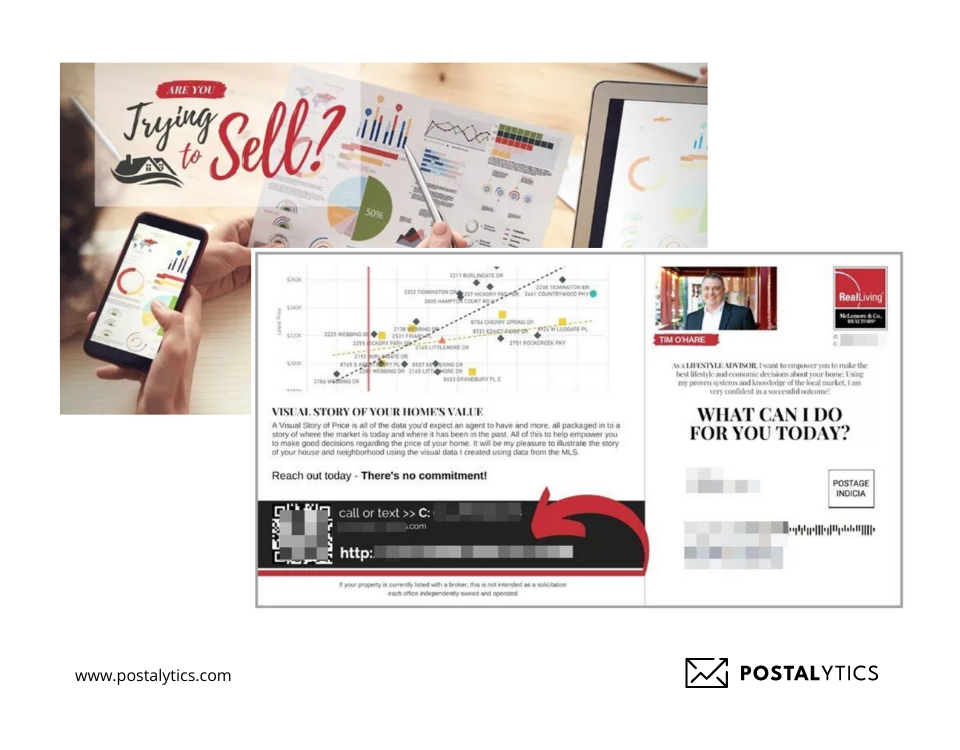
Less competition
Most companies are switching to digital marketing initiatives. This means that if you want to beat the competition, you have to introduce different methods.
Direct marketing can be one of those methods.
People also love receiving physical mail, and thus a thoughtfully designed mailer can catch your audience’s attention and help you beat the competition.
Better response rates
The research found that direct marketing gets a better response rate than email marketing. By complementing the two, you can get even better results.
This is, in part, due to highly personalized direct mail campaigns.
For example, J.M. Sells Law Ltd stood out in a crowded market by using the different personalization features in Postalytics for direct mail advertising.
After identifying a potential client, the firm gathered relevant demographic information about the individual. This information was stored in a CRM, and by integrating Postalytics with these CRM tools, they managed to cut through the noise and send personalized, triggered mail at the right time.
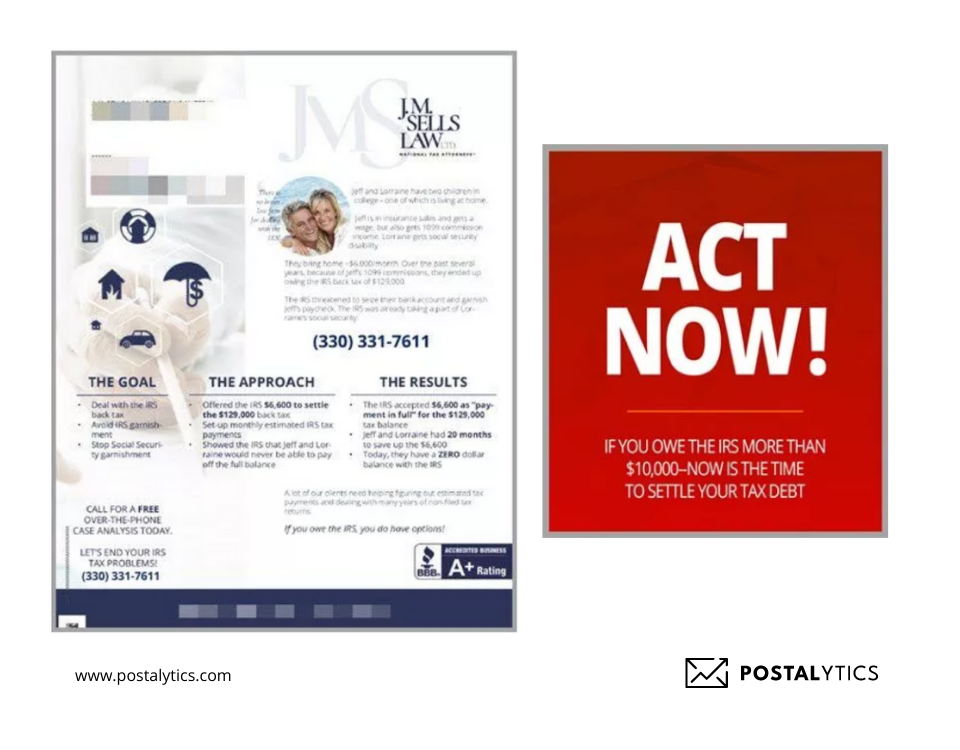
They also used pURLs and QR codes to bring these prospects online and nurture them further.
The result was a 5% response rate with a 75% conversion rate.
How to Maximize the Efficiency of Direct Mail Campaigns?
Here are seven strategies our clients often use to maximize the efficiency of their direct mail marketing efforts.
Define your campaign goals
Without a clear goal, you might be unable to target your audience effectively. Ask yourself, “What are we trying to achieve with our campaign?” Are we trying to generate leads? Or are we spreading awareness about the upcoming sale?
A clear goal helps you make decisions easily. For example, it guides the copy you’ll create, the CTAs you’ll use, and the design that will attract attention.
Target the right audience
For a campaign to reach the right people, your mailing list should cover those who will find the direct mail piece educational or engaging.
For example, sending a newsletter mail to someone who hasn’t been active with your other content campaigns would waste your resources.
If you have sent direct mail campaigns earlier, you can gather insights from those who acted on your CTA, the demographics of those people, and any other common factors you can leverage.
With Postalytics, you can update your mailing lists to connect with the right target customers.
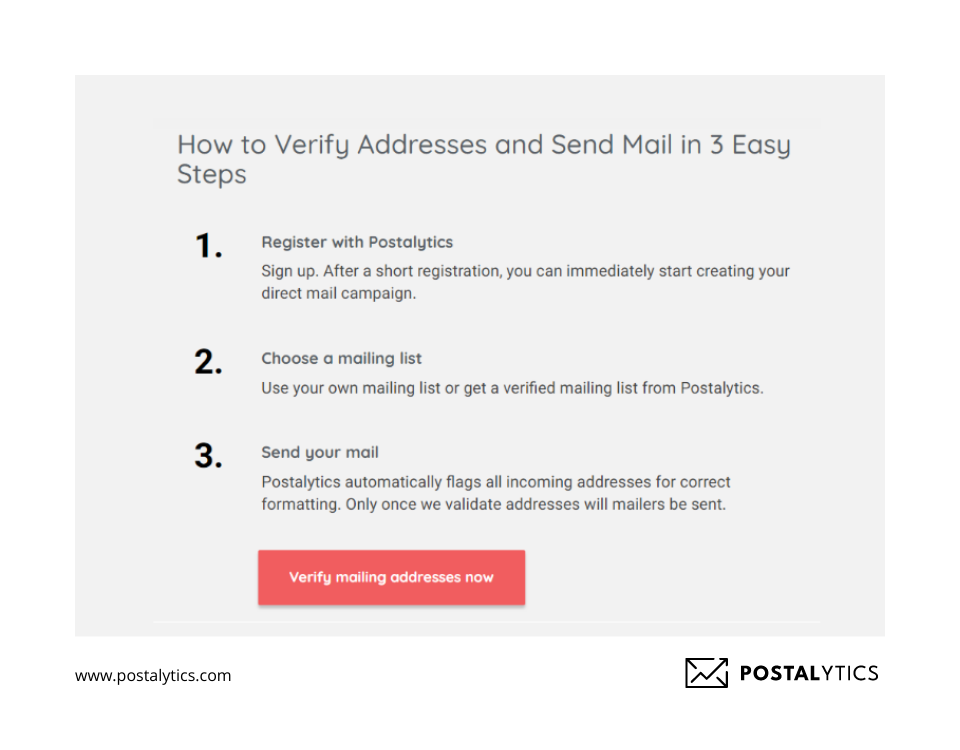
Pick a mailing list
After narrowing down your target audience, the next step is to pick a mailing list.
The best way is to use an in-house list instead of purchasing one. To do that, go through your previous campaigns, or you can gather information on your existing customers from your CRM.
If you do not have any ready information, you can start fetching information from your most important platforms. For example, if you’re getting good engagement from social media, run a contest or giveaway where you can fetch customer information in exchange for a prize or a reward.
Add a call-to-action (CTA)
Your CTA is undoubtedly one of the most crucial elements of your direct mail piece. Without a strong CTA that encourages action, you won’t be able to drive conversions with your direct mail marketing.
Also, ensure that your CTA matches the goal of your campaign. For example, if your goal is to increase revenue, your CTA should be something like “Buy today” or “Activate the best deal today.”
Here are some best practices for crafting engaging CTAs.
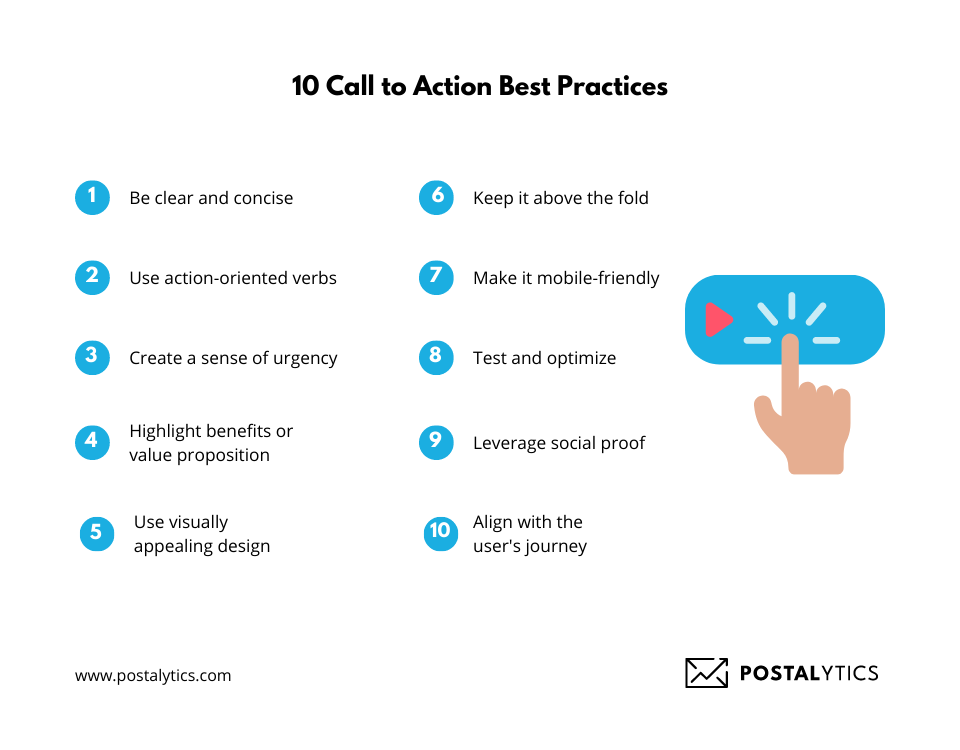
Picking a color for your CTA button is also important. Here’s some actionable information on what different colors signify.
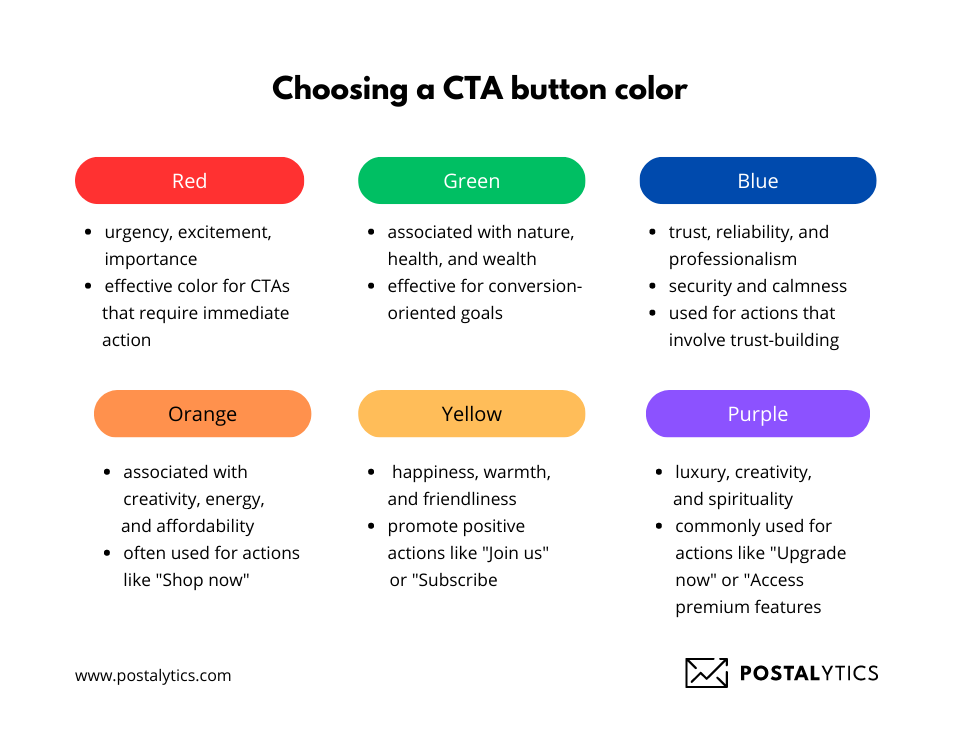
Make a powerful design piece
A great direct mail marketing piece puts attention to small details. For example, picking the right color for your piece is as important as selecting the font style and size of the copy.
Here are some things you should pay attention to while creating the design:
- Pick the right direct mail format from postcards, self-mailers, letters, brochures, catalogs, and dimensional mailers.
- Stick to a consistent theme. Don’t use more than two or three font styles
- If you’re selecting imagery, ensure it’s sharp and doesn’t crowd the text.
- Use a grid layout to have a proper placement for all the elements
- Have your CTA in a prominent place that is easily discoverable
Test run your campaign
Before sending the direct mail pieces, proof your design first. After all, you don’t want to send a direct mail letter with a typo or an error in the addressee’s name.
Digital proofs in Postalytics allow you to:
- Check for grammar, spelling, or formatting errors
- Ensure that your text and images are placed in proper areas so they don’t get trimmed during the cutting process
- Visually inspect image quality for clarity
- Ensure that the background image is formatted properly
By conducting this process, you can save a lot of time and money.
Send mail and analyze results
Once you have done the work, it’s time to deploy your campaigns and see how it works.
While analyzing the results, focus on your key metrics. For example, if you have used QR codes on your mail pieces, track how many people have scanned those and their activities on your site.
You can even track how many people have taken action on your CTAs. For example, if the CTA was focused on increasing sales, look at the increase in sales after you sent those direct mailers.
Key Takeaways
Direct mail offers businesses a more personalized way to reach and engage consumers that delivers results.
While deploying these campaigns can be expensive and time-consuming, there are ways to make them more efficient and affordable. One way is using tools like Postalytics that make your workflows seamless and efficient and reduce your turnaround time from weeks to days.
Get started with your free trial today.
About the Author

Dennis Kelly
Dennis Kelly is CEO and co-founder of Postalytics. Dennis joined Boingnet, the predecessor to Postalytics, in 2013. Boingnet was focused on providing print and direct mail marketing service providers the ability to add digital marketing channels to their direct mail campaigns. Postalytics is Dennis’ 6th startup. He has been involved in starting and growing early-stage technology ventures for over 30 years and has held senior management roles at a diverse set of large technology firms including Computer Associates, Palm Inc. and Achieve Healthcare Information Systems.

